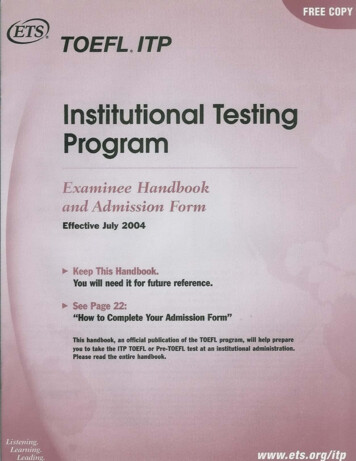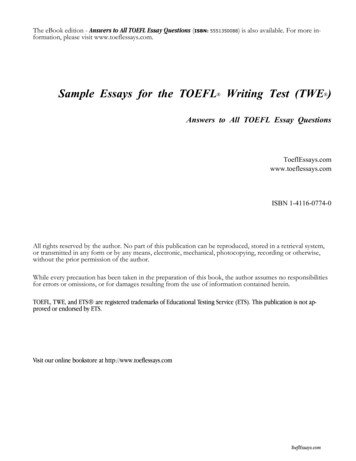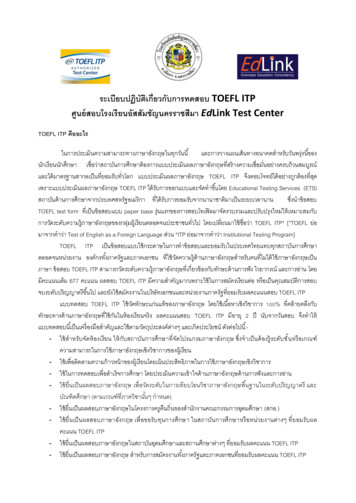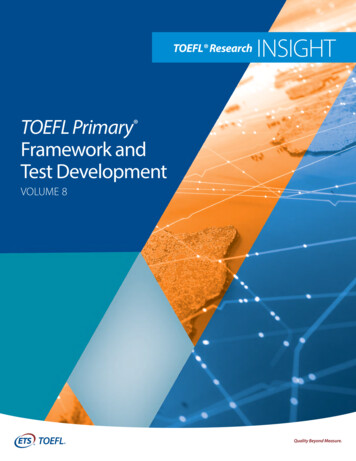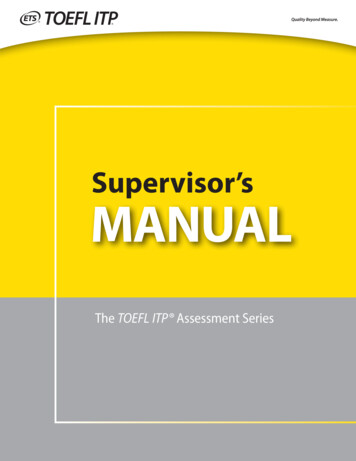
Transcription
Supervisor’sMANUALThe TOEFL ITP Assessment Series
Copyright 2016 by Educational Testing Service. All rights reserved. ETS, the ETS logo, TOEFL and TOEFL ITP are registered trademarks ofEducational Testing Service (ETS) in the United States and other countries. MEASURING THE POWER OF LEARNING is a trademark of ETS.No part of this publication may be reproduced or transmitted in any form or by any means, electronic or mechanical, including photocopy,recording or any other information storage or retrieval system, without permission in writing from ETS, Princeton, NJ 08540, USA.
WHAT THIS MANUAL IS ABOUTThis manual provides specific information about the general procedures and security responsibilities of theTOEFL ITP test administrator, including procedures that administrators must follow before, during, and after eachtesting session. Critical procedures are outlined to help the administrator carry out these responsibilities smoothlyand effectively.You can help ensure that the test administration is efficient, fair, and secure by following these directions exactly.Test scores will be meaningful only if all administrators follow the same testing procedures and give the sameinstructions to all test takers.The procedures outlined in this manual represent the highest standard for secure test administrations. It is extremelyimportant that test takers understand the general test directions. If the local ETS TOEFL ITP associate feels it isappropriate, the general test directions may be translated into the local language, and the test administrator mayread the translated directions to the test takers.As test administrator, you must be primarily concerned with safeguarding all aspects of test security, conducting thetest efficiently and quietly, protecting the test takers from disturbance, and ensuring protection of the test materialsfrom loss or unauthorized access. The test administrator is responsible for the security of all tests from the time theyare received until they are promptly returned to ETS or the local ETS TOEFL ITP associate. This means that no one isto have the opportunity to examine any test book at any time except the test taker taking the test. Also, no one maybe permitted to copy or retain copies of the test questions.Please inform your assistants of the importance of security and see that they enforce all security rules withoutexception.If you have any questions prior to or on the day of the test, contact your local ETS TOEFL ITP associate or ETS.Communicating with ETS:TOEFL Institutional Services:Phone: 609-771-7550Fax number: 973-735-1903Email: ITP@ets.orgMailing address:TOEFL Institutional ServicesETSPO Box 6156Princeton, NJ 08541-6156, USA1
ContentsWHAT THIS MANUAL IS ABOUT . . . . . . . . . . . . . . . . . . . . . . . . . . . . . . . . . . 1OVERVIEW OF THE TOEFL ITP PROGRAM . . . . . . . . . . . . . . . . . . . . . . . . 4Test Structure. . . . . . . . . . . . . . . . . . . . . . . . . . . . . . . . . . . . . . . . . . . . . . . . . . . . . . . . 4TIPS FOR PREVENTING SECURITY BREACHES. . . . . . . . . . . . . . . . . . . . . 5Test Materials. . . . . . . . . . . . . . . . . . . . . . . . . . . . . . . . . . . . . . . . . . . . . . . . . . . . . . . . 5Impersonation. . . . . . . . . . . . . . . . . . . . . . . . . . . . . . . . . . . . . . . . . . . . . . . . . . . . . . . 5Copying. . . . . . . . . . . . . . . . . . . . . . . . . . . . . . . . . . . . . . . . . . . . . . . . . . . . . . . . . . . . . 5Collecting Answer Sheets . . . . . . . . . . . . . . . . . . . . . . . . . . . . . . . . . . . . . . . . . . . . 5ACTIVITIES BEFORE TEST DAY . . . . . . . . . . . . . . . . . . . . . . . . . . . . . . . . . . . 6Selecting Your Staff . . . . . . . . . . . . . . . . . . . . . . . . . . . . . . . . . . . . . . . . . . . . . . . . . . 6Types of Assistants . . . . . . . . . . . . . . . . . . . . . . . . . . . . . . . . . . . . . . . . . . . . . . . . . 6Training Your Staff. . . . . . . . . . . . . . . . . . . . . . . . . . . . . . . . . . . . . . . . . . . . . . . . . . . . 7Security of Test Materials. . . . . . . . . . . . . . . . . . . . . . . . . . . . . . . . . . . . . . . . . . . . . 7Receiving and Storing Test Materials. . . . . . . . . . . . . . . . . . . . . . . . . . . . . . . . 7Checking Test Materials. . . . . . . . . . . . . . . . . . . . . . . . . . . . . . . . . . . . . . . . . . . . . 7Selecting Test Center Facilities. . . . . . . . . . . . . . . . . . . . . . . . . . . . . . . . . . . . . . . . 7Selecting Testing Rooms. . . . . . . . . . . . . . . . . . . . . . . . . . . . . . . . . . . . . . . . . . . . 7Size of Testing Rooms . . . . . . . . . . . . . . . . . . . . . . . . . . . . . . . . . . . . . . . . . . . . . . 7Physical Requirements of Testing Rooms. . . . . . . . . . . . . . . . . . . . . . . . . . . . 7Audio Playback Equipment and CDs. . . . . . . . . . . . . . . . . . . . . . . . . . . . . . . . . . 8Test Taker Handbook and Admission Form. . . . . . . . . . . . . . . . . . . . . . . . . . . . 8Test Takers with Disabilities or Health-related Needs. . . . . . . . . . . . . . . . . . . 8ACTIVITIES ON THE DAY OF THE TEST . . . . . . . . . . . . . . . . . . . . . . . . . . . . 9Test Day Preparations. . . . . . . . . . . . . . . . . . . . . . . . . . . . . . . . . . . . . . . . . . . . . . . . 9Humanizing the Test Administration. . . . . . . . . . . . . . . . . . . . . . . . . . . . . . . . 9Materials Checklist . . . . . . . . . . . . . . . . . . . . . . . . . . . . . . . . . . . . . . . . . . . . . . . . . 9Inside the Testing Room. . . . . . . . . . . . . . . . . . . . . . . . . . . . . . . . . . . . . . . . . . . . 9Equipment/Facilities Checklist. . . . . . . . . . . . . . . . . . . . . . . . . . . . . . . . . . . . . . 9Problematic Conditions. . . . . . . . . . . . . . . . . . . . . . . . . . . . . . . . . . . . . . . . . . . . . 9Test Center Procedures and Regulations . . . . . . . . . . . . . . . . . . . . . . . . . . . . . 10Visitors. . . . . . . . . . . . . . . . . . . . . . . . . . . . . . . . . . . . . . . . . . . . . . . . . . . . . . . . . . . . 10Conduct and Prohibited Materials . . . . . . . . . . . . . . . . . . . . . . . . . . . . . . . . . 10Admission Procedures. . . . . . . . . . . . . . . . . . . . . . . . . . . . . . . . . . . . . . . . . . . . . . . 11Institutional Administration . . . . . . . . . . . . . . . . . . . . . . . . . . . . . . . . . . . . . . . 11Public Administration . . . . . . . . . . . . . . . . . . . . . . . . . . . . . . . . . . . . . . . . . . . . . 11Identification. . . . . . . . . . . . . . . . . . . . . . . . . . . . . . . . . . . . . . . . . . . . . . . . . . . . . . 11Identification (ID) Requirements. . . . . . . . . . . . . . . . . . . . . . . . . . . . . . . . . . . 11Acceptable Primary ID Documents. . . . . . . . . . . . . . . . . . . . . . . . . . . . . . . . . 11Acceptable Supplemental ID Documents . . . . . . . . . . . . . . . . . . . . . . . . . . 122
Unacceptable ID Documents . . . . . . . . . . . . . . . . . . . . . . . . . . . . . . . . . . . . . . 12Seating Procedures . . . . . . . . . . . . . . . . . . . . . . . . . . . . . . . . . . . . . . . . . . . . . . . . . 12Test Taker Seating Plan . . . . . . . . . . . . . . . . . . . . . . . . . . . . . . . . . . . . . . . . . . . . 13Closing the Testing Room. . . . . . . . . . . . . . . . . . . . . . . . . . . . . . . . . . . . . . . . . . 13ACTIVITIES DURING THE TEST . . . . . . . . . . . . . . . . . . . . . . . . . . . . . . . . . . 14Distributing and Accounting for Test Materials. . . . . . . . . . . . . . . . . . . . . . . 14Distributing Answer Sheets. . . . . . . . . . . . . . . . . . . . . . . . . . . . . . . . . . . . . . . . 14Distributing Test Books. . . . . . . . . . . . . . . . . . . . . . . . . . . . . . . . . . . . . . . . . . . . 14Maintaining Security . . . . . . . . . . . . . . . . . . . . . . . . . . . . . . . . . . . . . . . . . . . . . . 14Posting the Time. . . . . . . . . . . . . . . . . . . . . . . . . . . . . . . . . . . . . . . . . . . . . . . . . . 14Background Questionnaire. . . . . . . . . . . . . . . . . . . . . . . . . . . . . . . . . . . . . . . . 15Test Taker Comments. . . . . . . . . . . . . . . . . . . . . . . . . . . . . . . . . . . . . . . . . . . . . . 15INSTRUCTIONS FOR ADMINISTERING THE TESTS . . . . . . . . . . . . . . . . 16ACTIVITIES AFTER THE TEST. . . . . . . . . . . . . . . . . . . . . . . . . . . . . . . . . . . . 21Collecting Test Materials and Dismissing Test Takers. . . . . . . . . . . . . . . . . . 21When the Test is Over, Do the Following:. . . . . . . . . . . . . . . . . . . . . . . . . . . 21Returning Materials . . . . . . . . . . . . . . . . . . . . . . . . . . . . . . . . . . . . . . . . . . . . . . . 21Special Instructions . . . . . . . . . . . . . . . . . . . . . . . . . . . . . . . . . . . . . . . . . . . . . . . 21TEST MATERIAL RETURN INSTRUCTIONS. . . . . . . . . . . . . . . . . . . . . . . . 22APPENDIX A . . . . . . . . . . . . . . . . . . . . . . . . . . . . . . . . . . . . . . . . . . . . . . . . . . . 23Irregularities and Exceptional Situations. . . . . . . . . . . . . . . . . . . . . . . . . . . . . 23Reporting Irregularities. . . . . . . . . . . . . . . . . . . . . . . . . . . . . . . . . . . . . . . . . . . . 23Handling Specific Irregularities. . . . . . . . . . . . . . . . . . . . . . . . . . . . . . . . . . . . . . 24Test Material Flaws. . . . . . . . . . . . . . . . . . . . . . . . . . . . . . . . . . . . . . . . . . . . . . . . 24Group Irregularities. . . . . . . . . . . . . . . . . . . . . . . . . . . . . . . . . . . . . . . . . . . . . . . 25Individual Irregularities. . . . . . . . . . . . . . . . . . . . . . . . . . . . . . . . . . . . . . . . . . . . 26Security and Conduct Irregularities . . . . . . . . . . . . . . . . . . . . . . . . . . . . . . . . 27APPENDIX B: TOEFL ITP BACKGROUND QUESTIONNAIRE . . . . . . . . 29APPENDIX C: FORMS . . . . . . . . . . . . . . . . . . . . . . . . . . . . . . . . . . . . . . . . . . . 31SAMPLE ANSWER SHEET . . . . . . . . . . . . . . . . . . . . . . . . . . . . . . . . . . . . . . . . . . . . 32SUPERVISOR COMMENT SHEET. . . . . . . . . . . . . . . . . . . . . . . . . . . . . . . . . . . . . . 33SUPERVISOR REPORT FORM. . . . . . . . . . . . . . . . . . . . . . . . . . . . . . . . . . . . . . . . 34SUPERVISOR IRREGULARITY REPORT. . . . . . . . . . . . . . . . . . . . . . . . . . . . . . . . . 35SEATING CHART. . . . . . . . . . . . . . . . . . . . . . . . . . . . . . . . . . . . . . . . . . . . . . . . . . . . . 37VIOLATIONS NOTICE . . . . . . . . . . . . . . . . . . . . . . . . . . . . . . . . . . . . . . . . . . . . . . . . 38TEST TAKER COMMENT FORM . . . . . . . . . . . . . . . . . . . . . . . . . . . . . . . . . . . . . . 39DUTIES OF ROOM PROCTORS. . . . . . . . . . . . . . . . . . . . . . . . . . . . . . . . . . . . . . . 41COUNTRY AND REGION CODES. . . . . . . . . . . . . . . . . . . . . . . . . . . . . . . . . . . . . 43NATIVE LANGUAGE CODES . . . . . . . . . . . . . . . . . . . . . . . . . . . . . . . . . . . . . . . . . 443
OVERVIEW OF THE TOEFL ITP PROGRAMThe TOEFL ITP Assessment Series offers colleges anduniversities, English language learning programs andother organizations the opportunity to administera convenient, affordable and reliable assessment ofEnglish language skills.TOEFL ITP tests are paper based and use 100 percentacademic content to evaluate the English-languageproficiency of nonnative English speakers. All questionsare in multiple-choice format with four answer choicesper question. The tests evaluate skills in three areas: Listening Comprehension measures the ability tounderstand spoken English as it is used in collegesand universities.Structure and Written Expression measuresrecognition of selected structural and grammaticalpoints in standard written English.Reading Comprehension measures the ability toread and understand academic reading materialwritten in English.TOEFL ITP offers two tests — Level 1 (formerly TOEFLITP) and Level 2 (formerly Pre-TOEFL). The Level 1test evaluates students’ knowledge of English at theintermediate to advanced levels of English languagestudies. The Level 2 test evaluates students’ knowledgeof English at the high beginning to intermediate levels.It measures the same language skills as the Level 1 testbut is less difficult and requires less testing time. Thereare minor differences in the question types betweenLevels 1 and 2.Reliability StudyReliability is an important criterion to measure thequality of an assessment product. Tests with highreliability yield consistent scores across different testforms. Refer to the TOEFL ITP reliability table (PDF) forfurther details.Test StructureLevel 1SectionNumber of QuestionsAdministration TimeScore ScaleListening Comprehension5035 minutes31 – 68Structure and Written Expression4025 minutes31 – 68Reading Comprehension5055 minutes31 – 67TOTAL140115 minutes310 – 677Number of QuestionsAdministration TimeScore ScaleListening Comprehension3022 minutes20 – 50Structure and Written Expression2517 minutes20 – 50Reading and Vocabulary4031 minutes20 – 50TOTAL9570 minutes200 – 500Level 2Section4
TIPS FOR PREVENTING SECURITY BREACHESTest Materials Never leave test materials unattended. Distribute and collect test books individually. Ensure that no test taker leaves the room with test materials. Ensure that no test taker copies, removes, records or photographs any portion of thetest materials.Impersonation Check test takers’ identification and documents thoroughly at the time they enter the assignedtesting rooms and as they return the completed test materials. Limit the number of test takers permitted to leave the testing room at the same time.Copying Never allow test takers to select their own seats. Randomly assign test takers to specific seats in each testing room. Seat test takers a minimum of 1.5 meters apart. Seat all test takers facing the same direction in each room. Document in writing the test taker seating plan, showing test taker name, seat location, andserial number of test book. Observe and check answer sheets throughout the testing session to ensure that they are beingproperly gridded with a No. 2 or HB (soft lead) pencil.Collecting Answer Sheets Check the first four letters of the gridded name against the first four letters of the printedname when collecting each answer sheet. Check test takers’ identification documents thoroughly at the time they return the completedtest materials.5
ACTIVITIES BEFORE TEST DAYAs test administration supervisor, you assume fullresponsibility for all details of the test administration atyour institution. Therefore, you should be thoroughlyfamiliar with the instructions in this manual before thetesting session. Uniform procedures are essential instandardized testing; the scores of all individualstested at institutional administrations will becomparable only if all supervisors adhere to the sameschedule and administer the test in the same way. It isimportant that you follow these instructions to ensurethe comparability of the scores; statistical data forinterpreting scores are based on results obtained fromtests administered according to these directions.Selecting Your StaffTypes of AssistantsDepending on the number of test takers expected fora particular administration, you may require the helpof assistants, either as associate supervisors or roomproctors.All of your assistants must be: familiar with the contents of this manualreliable and capable of attending to detailsrepresentative of the group being testedknowledgeable about testing procedures forindividuals with disabilities or health-related needsable to communicate with test takers in the commonlanguage of the institutionDuring the testing session, test administration staffmust not read (for their own amusement), engage inconversation, correct papers, or perform any other taskthat is not related to their test administration duties. Inaddition, they must not examine the contents of anytest book unless they are inspecting it for a possibledefect reported by a test taker. Under no circumstancesshould test administration staff take the TOEFL ITP testduring the testing session.Associate supervisors are responsible for the testadministration in the room(s) assigned to them. In theirtesting rooms, they perform the same function andbear the same responsibilities as the test administrationsupervisor. They must read this manual before the day ofthe test, be thoroughly familiar with all procedures, beof unquestionable integrity, and be mature and able tohandle groups of test takers in an effective and friendlymanner. Associate supervisors should not be allowed to6administer the test to someone they know personally,other than as a student at the institution.Proctors help with test administration duties but do notadminister the test. They may be professional personnel;responsible administrative, secretarial or clerical staff; orgraduate students. Although the actual duties of eachproctor depend on the type of assistance required,proctors generally assist with or perform the followingfunctions: post directional signs in the building where the testwill be administered, or direct test takers to theirassigned rooms check test takers’ identification seat test takers according to the instructions distribute test materials to each test taker walk around the testing room frequently to ensurethe quality of the audio recording, guard againstmisconduct, verify that every test taker is workingon the appropriate section of the test and makesure that test takers are gridding their answersheets properly collect test materials at the end of the testadministrationThe number of proctors you will need depends on thenumber of individuals you plan to test in each room. Itis important to have at least two staff members in eachroom. This allows verification by a second staff memberin cases of test booklet discrepancies or suspectedcheating. It also assures that should an emergencyoccur, there is someone to monitor the room while theroom supervisor deals with the emergency. Please usethe following table to determine the number of proctorsyou will need.Test Taker/Proctor RatiosNumber of Test Takersper RoomNumber of Proctors1–2526–5051–7576–1001234If more than 25 test takers are tested in one room, youwill need one proctor for every 25 test takers. You mayexcuse proctors if you find that you are overstaffed dueto test taker absenteeism. Proctors must be assigned torooms randomly. They should not be assigned to roomsin which they work or which they use on a regular basis.
Training Your StaffSelecting Test Center FacilitiesYou are responsible for training your staff before thetest date to effectively fulfill their test administrationduties as prescribed in this manual. You must ensurethat they know the specific test administrationprocedures, are aware of security-related issues, andunderstand the importance of safeguarding the testmaterials at all times.Selecting Testing RoomsThe success of any test administration depends, to agreat extent, on the suitability of the test site. It is moredifficult for test takers to concentrate on the test if noise,poor lighting, inadequate writing surfaces, extremetemperatures or humidity distracts them. Althoughcertain adverse conditions may be beyond the controlof the supervisor on the day of the test, careful planningwill minimize the possibility of such distractions. Whenselecting testing rooms, test supervisors must personallyinspect the rooms, choosing the best rooms based onoverall suitability. The following suggestions may behelpful in deciding what rooms to use.Security of Test MaterialsReceiving and Storing Test MaterialsETS and your local ETS TOEFL ITP associate assure alltest takers that no one but the test takers themselveswill be permitted to open or examine test books. Youare responsible for enforcing this rule from the momentyou receive the test materials until you return them inaccordance with the instructions in the materials sentto you.To meet this responsibility, you must: Have all test materials shipped directly to you oranother designated representative.Alert your receiving office that the shipment isexpected and arrange to have it delivered to youupon receipt.Arrange for secure conditions for receiving testmaterials. Test materials must be securely lockedin a container, compartment or area to which onlyone or two authorized people have access. Verifythat the locks on the secure storage area are not ona master key system which would allow a variety ofstaff, including janitorial, etc., to have access to thematerials.Checking Test MaterialsWithin 24 hours of receipt, open all boxes or envelopescontaining test materials and have two people check thecontents for counting or packing errors. If you do notcheck the test materials within 24 hours of receipt, youmay not have sufficient time to resolve problems priorto the test administration. If there is any discrepancy,contact ETS or your local ETS TOEFL ITP associateimmediately. After confirming that you have all thenecessary materials, reseal the boxes or envelopes withtape, sign your name across the tape and on the boxesor envelopes as added insurance against tampering,and store them in a secure area to which only you oranother authorized person have access. Test materialsmust never be left unattended when they are outsidea locked storage area.Size of Testing RoomsUsing large rooms such as lecture halls and cafeterias totest large numbers of test takers is often more efficientthan using small rooms. Therefore, if large rooms areavailable and there are no administrative problemstesting large groups, these rooms are appropriate to use.On the other hand, you may prefer to use small rooms ifyou think they provide more comfortable conditions forthe test takers, allow for better security, or if acousticsin the available large rooms are inadequate. As the testsupervisor, the final choice of the testing room(s) is yours.However, whatever room size you choose, the testingrooms must be arranged so that all test takers face thesame direction. There must be 1.5 meters between testtakers.Physical Requirements of Testing Rooms The temperature and ventilation should beappropriate for the season. Arrange in advance, ifpossible, for heating or cooling units to be turned onearly on testing day. Lighting must be adequate for reading and formarking answer sheets. Check lighting conditions inall testing rooms early on the day of the test. Each testing room must have a clock, preferably atthe front of the room. At regular intervals, post theamount of test time remaining. Rest rooms should be located nearby and should beeasy to find. Post directional signs if needed. Checkthe rest rooms before the test for any materials testtakers may have stored there. Test takers taking arest room break must not be allowed to use a cellphone or any other electronic device. The testing rooms should be located in a sectionof the building least likely to be affected by noisefrom construction work, parties, sports events,motorcycles, buses or other traffic.7
Audio Playback Equipment and CDsThe listening part of the TOEFL ITP test requires highfidelity audio playback equipment. Be sure to checkthe playback equipment before the day of the test tomake sure it functions properly. You will need to checkthe tone, volume and fidelity as well as the acousticsin the room(s) in which the equipment will be used.For each test administration, supervisors must have atleast two CDs for the audio part of the test, in case aCD malfunctions, is damaged by equipment, or is lost.Keep in mind that the CDs are secure test material, justlike a test book. CDs must be counted and verified by asecond staff member before being stored after the test.Be careful to check for CDs left in the playback machine.Test Taker Handbook and Admission FormWell in advance of the scheduled test date, you shouldgive each person planning to take the test a copyof the Test Taker Handbook and an admission form.The admission form is on the inside back cover of theHandbook; check each Handbook to be certain that theform is attached. Before you distribute the Handbooks,post a notice giving the date, time and place of thetest and other instructions. In addition, instruct thetest takers to complete their admission forms beforereporting to the testing room, and tell them to bringtheir completed admission form and several sharpenedmedium-soft (No. 2 or HB) black lead pencils with themon the day of the test. Also, remind them that the use ofbooks, dictionaries, recording or photographic devices,or papers of any kind will not be permitted and thatthese items should not be brought to the testing room.8Test Takers with Disabilities or Health-relatedNeedsEvery effort must be made to accommodate test takerswho require special testing conditions. If a test taker with adisability or health-related need will be taking the TOEFLITP test at your testing site, please make arrangementsin advance for special testing accommodations. If a testtaker requires accommodations (for example, extra time,assistance with completing the answer sheet, someoneto read the test questions aloud), contact ETS or thelocal ETS TOEFL ITP associate prior to the administrationto request specific materials. If a request is a relativelyminor one that you can accommodate easily, suchas accommodations for a wheelchair, seating near awindow for natural lighting, permission to leave theroom at intervals in order to eat a snack, you may, at yourdiscretion, accommodate the test taker provided that heor she understands that the test is to be administeredunder standard conditions and that he or she will berequired to adhere to all administrative procedures,requirements, and timing regulations.
ACTIVITIES ON THE DAY OF THE TESTSupervisors and associate supervisors must read thissection carefully before administering the tests. It isalso suggested that room proctors read this section.Test Day PreparationsHumanizing the Test AdministrationHumanizing the testing process is important to thesuccess of the administration. You may find the followingsuggestions helpful. Greet the test takers courteously to ease theiranxiety. Your words and behavior show the testtakers that they are welcome and that you are thereto help them. Stress the importance of this attitudewith your staff.Make testing staff visible. Have them wear badges,name tags, caps, ties or other identification that willenable test takers who are lost, confused or in needof assistance to find them easily.Post directional signs for the testing room(s) and restrooms before test takers arrive. In addition, if yourtesting site is large, post directional signs at strategiclocations on the grounds to direct test takers to theproper building(s).Treat all test takers equally. Test takers maybe nervous or sensitive during this importantexamination. You will want to make certain thatnone of your procedures makes one test taker feeldifferent from any other.Tolerate some nervous noise before the test starts.Many people under stress relieve their anxietythrough talk and movement.Be patient in responding to questions before the testbegins. Most questions are sincere. As long as testtakers confine their questions to the mechanics oftesting, do your best to answer them.Be prompt and sympathetic in responding to aquestion or procedure during the test. A test takerwho raises a hand and whispers a request foradditional help in understanding test proceduresshould receive your courteous, unobtrusiveattention if he or she clearly needs it.Be reasonable about requests to leave the room.Isolate anyone who is suspected of cheating ordisturbing others. This should be done withoutdisrupting the testing session or the other testtakers. Treat him or her reasonably and firmly, asdescribed later in this manual, and carry on with thetest in your usual way.Materials ChecklistBe sure you have enough of the following testingmaterials: This manual Test books Answer sheets CDs (verify that the test form designation on the CDis the same as on the test books) Code lists (Native Country and Native LanguageCodes are in the Test Taker Handbook) Supervisor’s Report Form Supervisor’s Comment Sheet Violations Notice Background Questionnaires, if applicable (seepage 15) Pencils (No. 2 or HB) and erasersInside the Testing RoomSet up the CD player with speakers located in theappropriate places and test the equipment in the testingroom. Run the CD to the beginning of the voice segment.Equipment/Facilities ChecklistCheck: Lighting Room temperature Room ventilation Location of outlets Audio recording equipment Distribution of tables/desks and chairs Location of blackboard Location of clock Rest rooms for concealed materialsProblematic ConditionsIf a last-minute change in testing rooms becomesnecessary, station a proctor at the original location todirect test takers to the new location. Before testingbegins, if you are aware of a potential noise problem(bands playing, heating systems banging, cheering ata sports event, scheduled maintenance or repair work,etc.), move the administration to another building or toanother room, if possible. In other situations, whereverpractical, ask people outside the testing room to leavethe area or talk more quietly. Even if it is impossible tototally avoid the noise, a few words from you will let thetest takers know that you are aware of the problem andhave made an effort on their behalf.9
Test Center Procedures and RegulationsVisitorsExcept for observers authorized by ETS and/or your localETS TOEFL ITP associate, visitors are not permitted toenter the room while testing is in progress. If a memberof the facility staff or maintenance worker requiresaccess during testing, check his/her identification andhave a proctor ac
Please inform your assistants of the importance of security and see that they enforce all security rules without exception. If you have any questions prior to or on the day of the test, contact your local ETS TOEFL ITP associate or ETS. Communicating with ETS: TOEFL Institutional Services: Phone: 609-771-7550 Fax number: 973-735-1903 Email: ITP .
